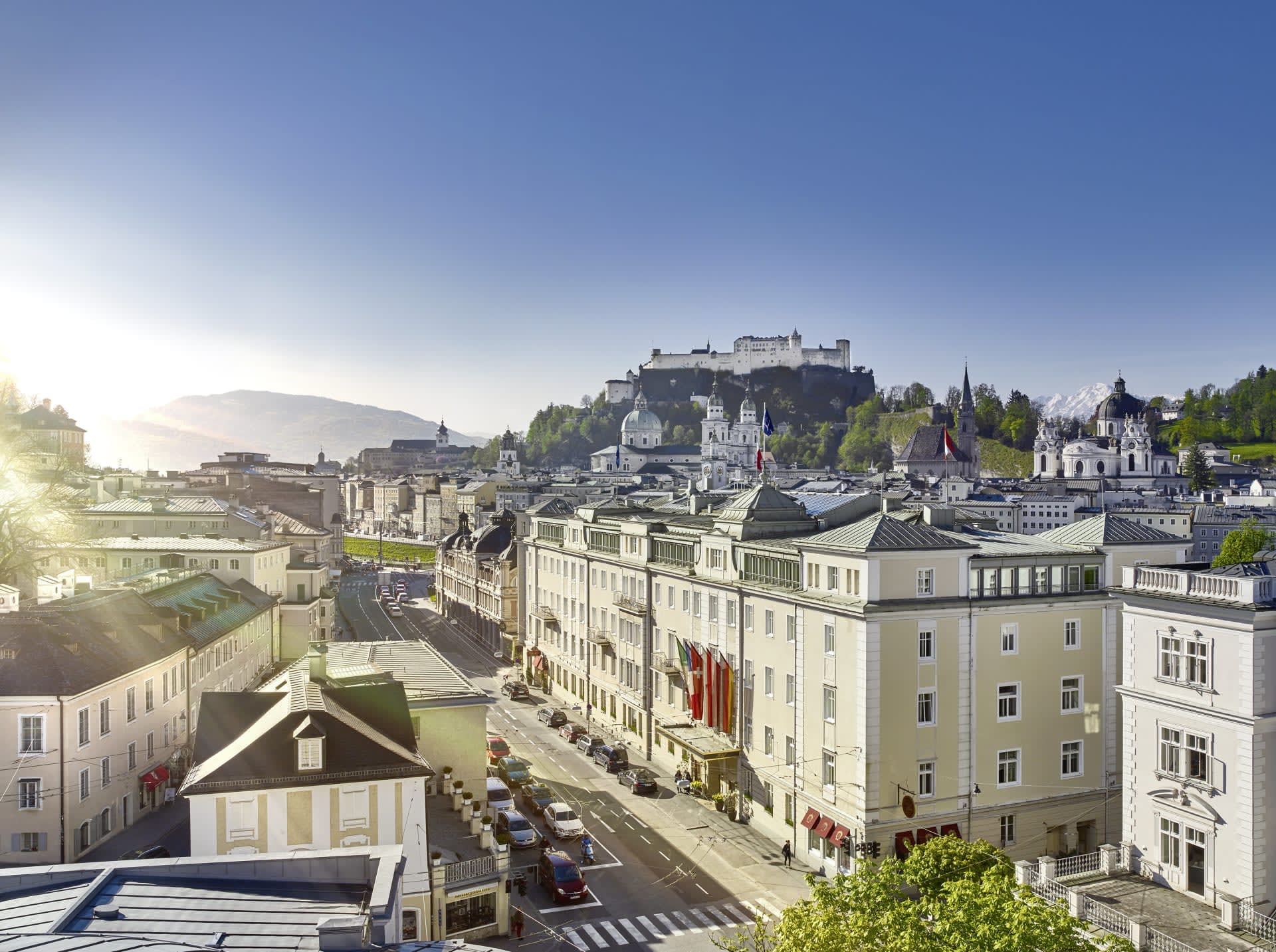
Image courtesy of Hotel Sacher Salzburg
Austria and Germany are where old-world charm meets epic scenery. From lakeside villages and mountaintop viewpoints to medieval squares and modern museums, this part of Europe packs in a mix of culture, history and jaw-dropping landscapes. One day you can explore imperial palaces or WWII landmarks, the next you can hike through meadows or sip wine in a storybook town. The food is hearty, the trains are efficient and there's a castle (or beer hall) around every corner.
Whether you're traveling as a couple, with family or on your own, Austria and Germany deliver a little something for every kind of traveler. Read on to discover where to stay, what to see and how to make the most out of a visit here.
Need to know
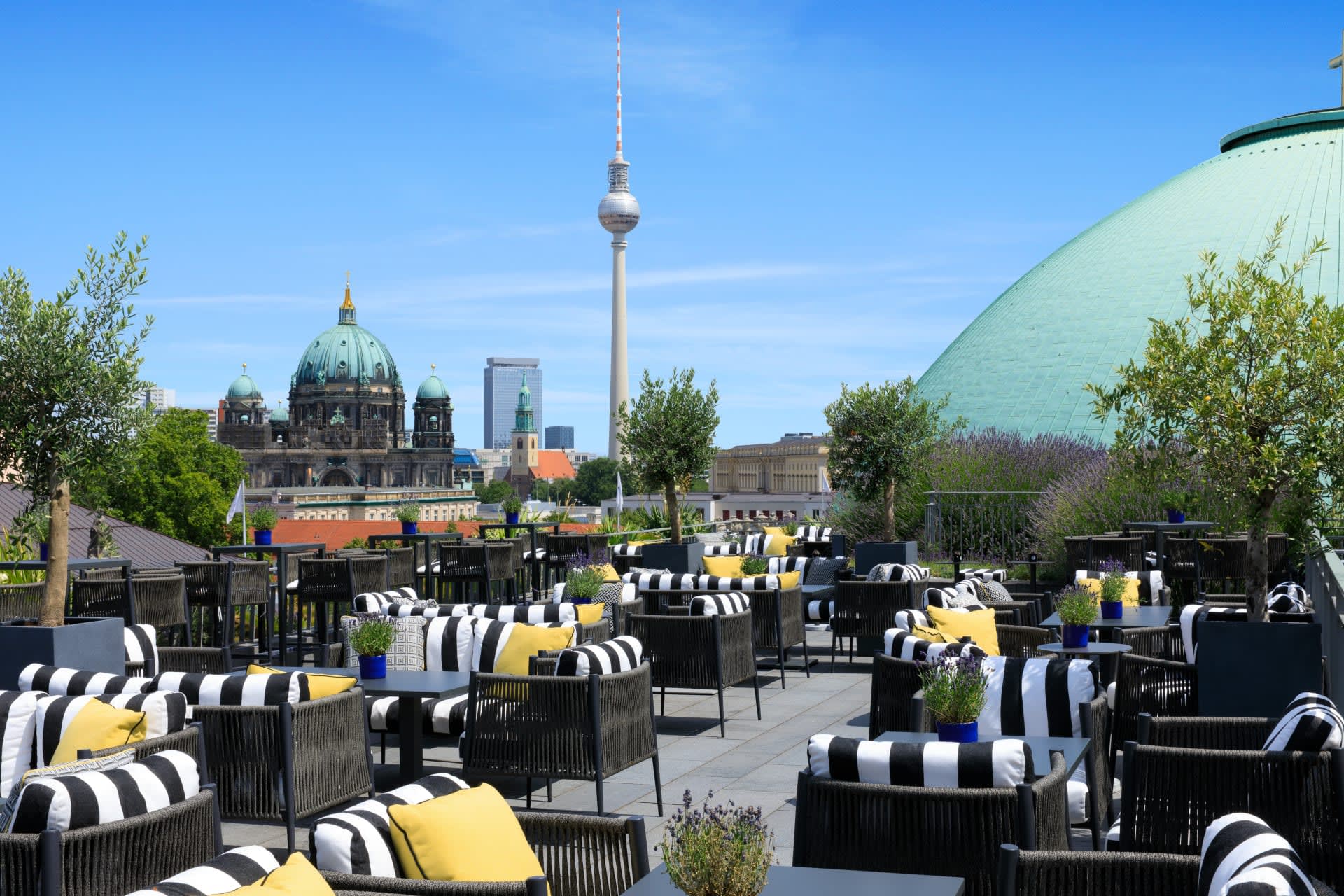
Image courtesy of Hotel de Rome, A Rocco Forte Hotel
A trip to Austria and Germany is made smoother with a few tips in your back pocket. Start by greeting with a polite “Guten Tag” in Germany or “Grüß Gott” in Austria. It’s a small gesture that goes a long way. Dining is a leisurely affair, so don’t rush meals, and keep voices low in public transit or residential areas where quiet is the norm. Churches are often open to visitors but cover your shoulders and knees as a sign of respect.
Both countries are safe and organized, with excellent public transportation and English-speaking pharmacy staff if you need help. Just be mindful of your belongings in crowded train stations and popular tourist spots.
Time is listed in 24-hour format. Power outlets require type C or F adapters. Many shops close on Sundays, so plan ahead. Reservations are also key, whether it’s for dinner in Vienna or a guided tour of Neuschwanstein Castle, since spots can fill quickly, especially in high season.
If you're driving, Fora Advisor Angela Walsh says, “have your International Driving Permit for both Germany and Austria, and purchase an Austrian highway sticker for driving in Austria.”
Currency: The Euro (EUR) is the official currency in both countries. Credit cards are widely accepted, but it’s smart to carry some cash for smaller shops, local cafés or tips (typically rounding up or adding 5–10%). ATMs are easy to find and usually offer fair exchange rates.
Languages: German is the official language of both Germany and Austria. English is widely spoken among younger generations and in hotels, restaurants and city stores.
Airports
Berlin: Berlin’s main international airport (BER) is well connected to major cities across Europe and the US. Direct flights are available from many hubs, and the airport is about 30–40 minutes from the city center by train or taxi.
Baden-Baden: Frankfurt International Airport (FRA) is the most convenient major airport for Baden-Baden, with direct flights from cities across the US and Europe. From Frankfurt, it’s about a 90-minute drive or two-hour train ride.
Munich: Served by Munich International Airport (MUC), it’s one of Europe’s busiest airports with many direct flights from major US and European cities.
Salzburg: Salzburg Airport (SZG) is a 15-minute drive from the city center, with connections from major European hubs. For international travelers, it’s often easiest to connect via Vienna, Frankfurt or Munich.
Vienna: Vienna International Airport (VIE) is the main hub for international travel into Austria. It offers nonstop flights from major cities around the world and is just 20–30 minutes from the city center by car or train.
Transportation
Berlin: The U-Bahn (subway), S-Bahn (commuter trains), trams and buses make it easy to get around the city quickly and affordably. Berlin is also very bike-friendly with dedicated bike lanes and rentals widely available. Many neighborhoods are walkable, especially areas like Mitte, Prenzlauer Berg and Kreuzberg.
Baden-Baden: One of the easiest and most scenic ways to get to Baden-Baden is by train, with frequent direct service from Frankfurt and Stuttgart. Private transfers are a great option, especially with luggage or after a long flight. The drive from Frankfurt is smooth and mostly on the autobahn. Renting a car is also a great way to explore the Black Forest.
Munich: The airport is directly connected to the city via the S-Bahn (S1 and S8 lines), taking about 35–45 minutes. A private transfer or taxi to the city center takes the same time, depending on traffic, and a great option if you’ve got luggage or a group. No car rental is needed, however, because once in Munich the public transportation system (U-Bahn, S-Bahn, trams, and buses) is clean, efficient and easy to navigate.
Salzburg: Direct train routes from Vienna, Munich and other European cities make rail travel a scenic and comfortable choice. For those coming from further out or undergoing group travel, a private transfer from cities like Munich (about 1.5 hours) or Vienna (about 2.5–3 hours) is a more convenient choice.
Vienna: The City Airport Train (CAT) runs nonstop from the airport to Wien Mitte in just 16 minutes. Vienna is also one of Europe’s best-connected rail cities. Direct high-speed trains link it to Salzburg, Prague, Budapest, Munich and beyond. If you’re coming from cities like Budapest or Prague with luggage or a group, a private transfer offers comfort and flexibility.
Best time to visit: Germany & Austria offer cities that are great no matter the time of year. Warmer months are great for outdoor adventures in the rolling hills of Austria and Black Forest of Germany.
Summer (June–August) is great for hiking in the Alps, biking through scenic countrysides and enjoying lakeside towns.
Fall (September–October) brings crisp air, golden foliage and Oktoberfest.
Winter (Late November–December) sees Christmas markets take over town squares with mulled wine, handmade gifts and festive lights.
Spring (March–May) is defined by blooming flowers, café patios reopening and fewer tourists — great for first-timers, history lovers and city explorers.
Ideal length of stay: Aim for at least 7–10 days to really start to experience the region. A week will allow you to see highlights like Munich, Salzburg and Vienna. Stretch your trip to 10 days or more to dive even deeper with various day trips or adventures into the Austrian Alps.
Signature dishes
Berlin: Currywurst (sausage with ketchup and curry powder), berliner (sugar-dusted jam-filled doughnut) and königsberger klopse (meatballs in creamy caper sauce).
Baden-Baden: Maultaschen (German-style ravioli, often in broth), black forest cake (chocolate, cream and cherries) and venison stew (rich and hearty, especially in fall).
Munich: Weißwurst (white sausage with mustard and pretzels), schweinshaxe (crispy pork knuckle) and obatzda (spiced cheese spread with bread).
Salzburg: Salzburger nockerl (light, fluffy dessert), kasnocken (cheesy dumplings with crispy onions) and tafelspitz (boiled beef with horseradish and sides).
Vienna: Wiener schnitzel (crispy veal cutlet with lemon), sachertorte (famous chocolate-apricot cake) and gulasch (beef stew with paprika).
Key phrases: hallo (hello), guten morgen (good morning), guten abend (good evening), tschüss or auf wiedersehen (goodbye), entschuldigung (excuse me / sorry), danke (thank you), bitte (please), and ja / nein (yes / no).
What to wear: Stick with comfortable shoes for walking and cobblestone streets. Light layers are great for the region’s changing weather. For dinners or concerts, go smart-casual — nice jeans, dresses or a jacket. A stylish coat is a great choice in cooler months.
Accessible hotels
Berlin: Hotel Adlon Kempinski Berlin
Munich: Sofitel Munich Bayerpost
Vienna: Rosewood Vienna
Berlin
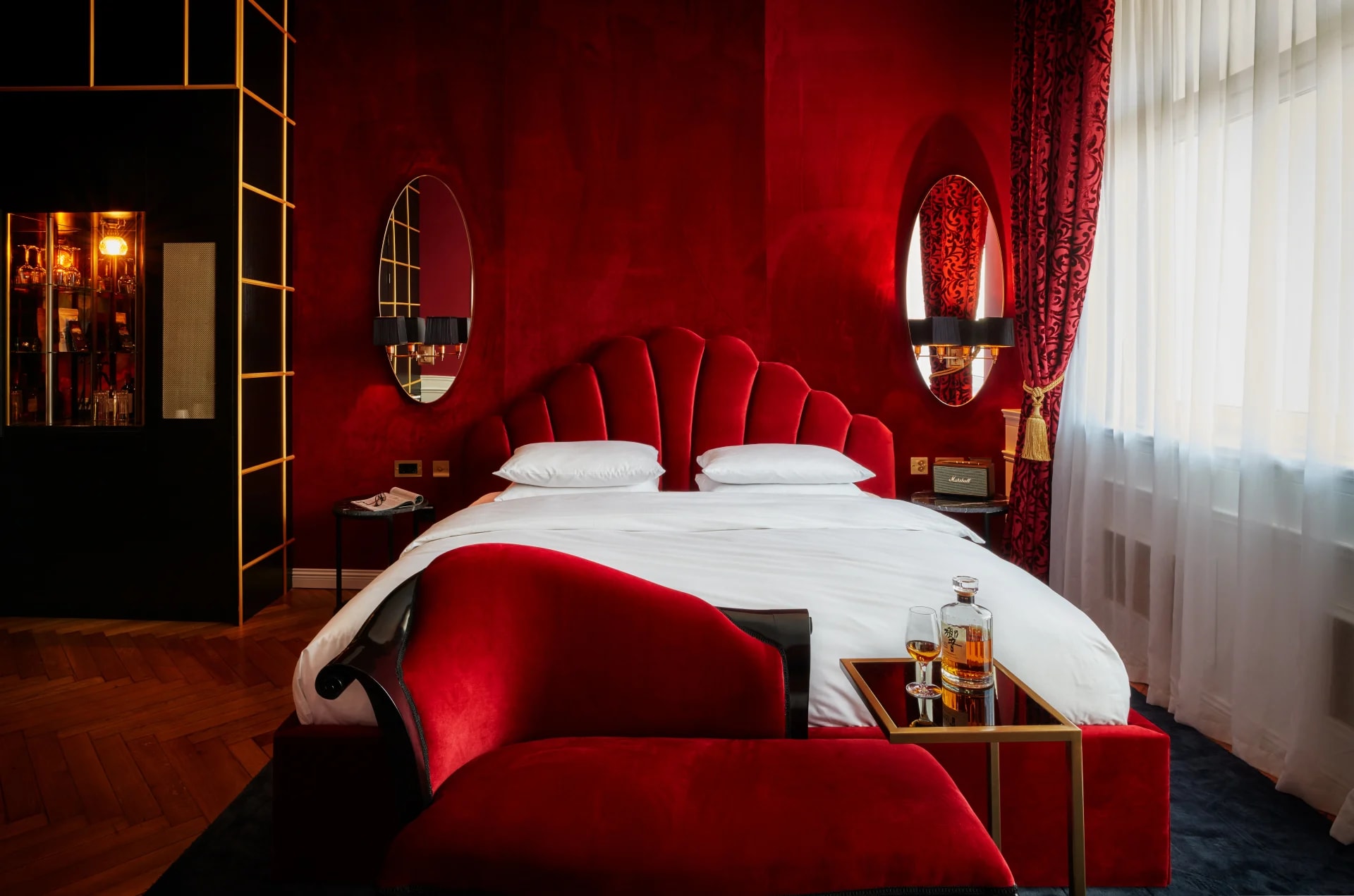
Image courtesy of Provocateur
Berlin is where history meets cutting-edge culture. From remnants of the Berlin Wall and world-class museums to creative neighborhoods packed with cafés, galleries and nightlife, the city offers a dynamic mix of old and new. Whether you're here for the history, the art scene or the energy, where you stay can also shape your entire Berlin experience.
Where to stay
Hotel de Rome, A Rocco Forte Hotel: Housed in a beautifully restored 19th-century bank building, this gem blends classic grandeur with contemporary style. Think high ceilings, original vaults turned into a spa and chic, spacious rooms, all in the heart of Berlin.
Fora’s Rocco Forte Knights partner perks include a $100 food & beverage credit, daily breakfast and upgrade whenever possible.
The Mandala Hotel: Calm, minimalist luxury right in the heart of the city, this retreat is just off bustling Potsdamer Platz. This all-suite hotel even has a Michelin-Starred restaurant (FACIL), a rooftop spa and is known for its top-tier service.
Fora’s Design Hotels partner perks include a hotel credit, daily breakfast and upgrade whenever possible.
Provocateur: This adults-only boutique hotel is bold, stylish and glamorous, tucked away in Berlin’s Charlottenburg district. Velvet drapes and vintage Parisian flair make it feel part speakeasy, part film noir fantasy for a totally one-of-a-kind experience.
Fora’s Design Hotels partner perks include a hotel credit, daily breakfast and upgrade whenever possible.
Baden-Baden

Image courtesy of Brenners Park-Hotel & Spa, Oetker Collection
Set at the edge of the Black Forest, Baden-Baden is all about wellness, nature and relaxation. Days here revolve around thermal spas, gardens and trails through the hills. Choosing the right place to stay makes all the difference in how you soak it all in.
Where to stay
Brenners Park-Hotel & Spa, Oetker Collection: This polished, classic retreat blends old-world elegance with top-tier wellness. Feeling more of a private residence, the service is impeccable and there’s direct access to Villa Stéphanie — one of Europe’s most celebrated spas.
Fora’s Oetker Pearl partner perks include a €100 food & beverage or spa credit, daily breakfast, upgrade & extended check-in/out whenever possible.
Munich
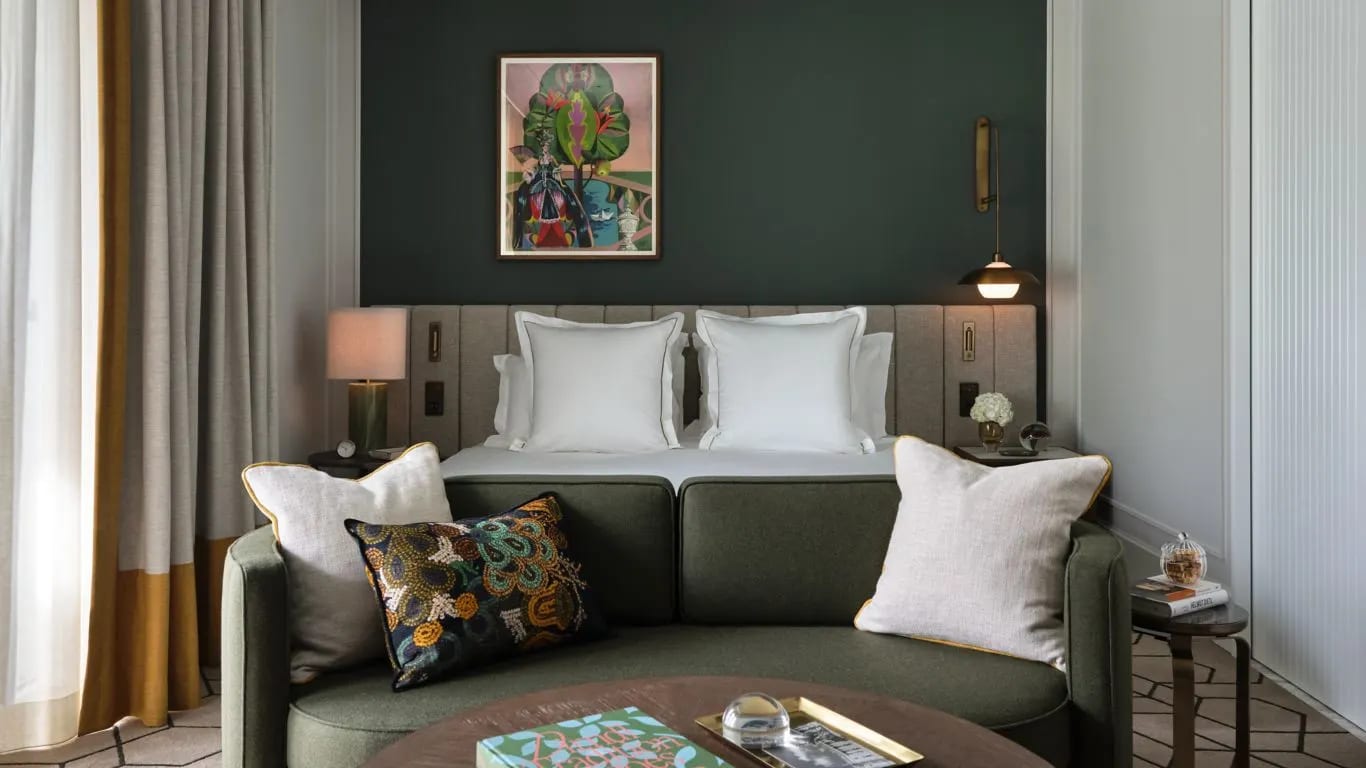
Image courtesy of Rosewood Munich
Munich blends Bavarian charm with a polished, modern edge. Expect beer gardens, historic landmarks and a vibrant city atmosphere — especially during Oktoberfest. With everything from luxury hotels to boutique options, where you stay can add an extra layer to your Munich experience.
Where to stay
Rosewood Munich: Housed in two restored historic buildings near Marienplatz, this retreat blends grand architecture with contemporary sophistication. From top-tier service and amenities to spacious rooms, it strikes the right balance of heritage and modern luxury.
Fora’s Rosewood Elite partner perks include a €100 food & beverage or spa credit, daily breakfast, upgrade and extended check-in/out whenever possible.
Louis Hotel: A contemporary and creative vibe combines with postcard-worthy views at this boutique retreat overlooking Viktualienmarkt. Relaxed yet refined with market-fresh breakfasts, in-room yoga kits and private balconies, it’s easy to explore Munich like a local.
“The Louis Hotel is absolutely lovely,” says Fora Advisor Melanie Pink. It’s right in the middle of old town, and during winter the Christmas markets are very close by.”
Fora’s Design Hotels partner perks include a food & beverage voucher, daily breakfast, upgrade & extended check-in/out whenever possible.
The Charles Hotel, a Rocco Forte Hotel: Set beside the Old Botanical Garden, this sanctuary combines quiet elegance with a prime location. Spacious rooms feature warm Bavarian touches, while the spa and Italian restaurant elevate the experience.
“The property combines contemporary style with classic elegance and offers a range of room types, all with lots of natural light and stylish artwork,” notes Fora Advisor Jane Henzerling. “One of my favorite features is the indoor pool, it's a true haven of relaxation.”
Fora’s Rocco Forte Knights partner perks include a $100 food & beverage credit, daily breakfast and upgrade whenever possible.
Salzburg
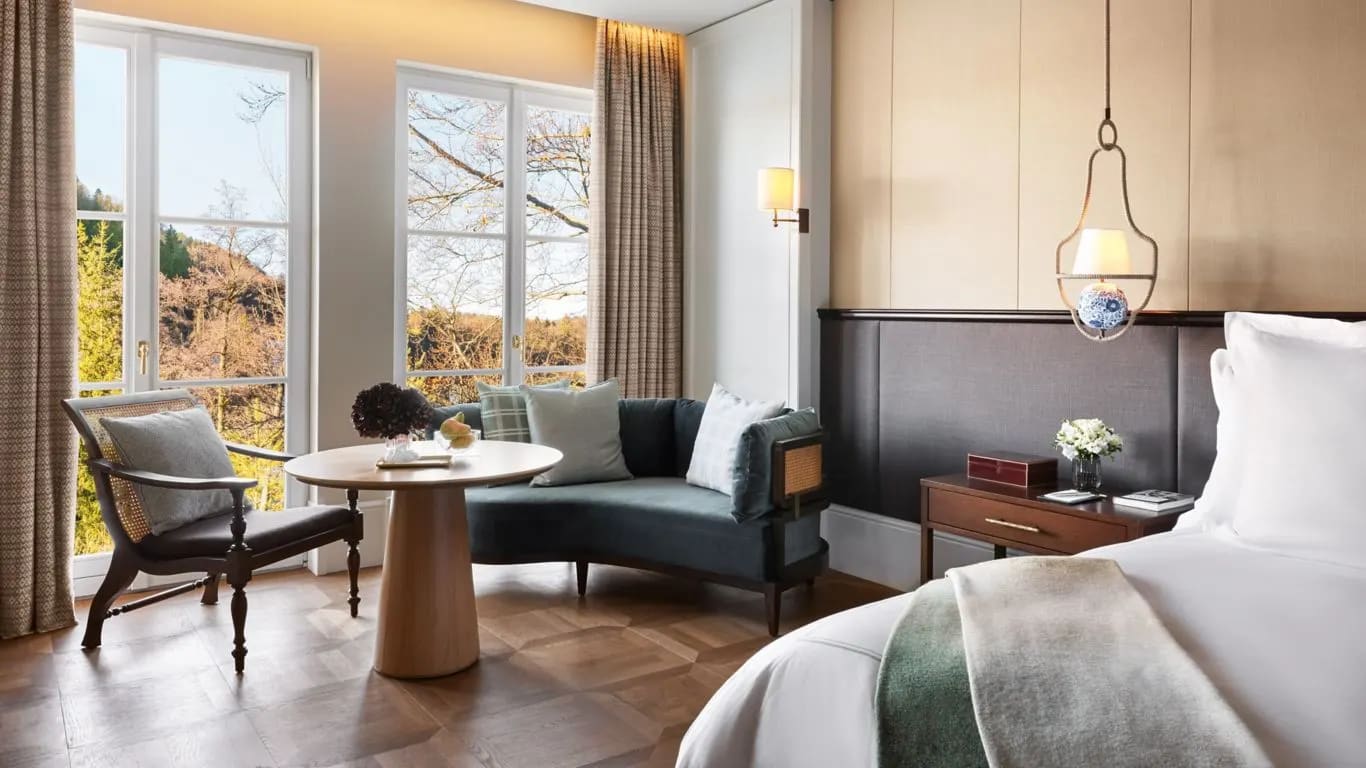
Image courtesy of Rosewood Schloss Fuschl
Salzburg feels like it’s been lifted from the pages of a storybook. With its baroque architecture, alpine views and ties to Mozart and “The Sound of Music,” the city delivers history and charm in equal measure. Whether you're here for the music, the mountains or the atmosphere, where you stay can set the tone for your Salzburg experience.
Where to stay
Rosewood Schloss Fuschl: Lakeside fairytale charm is everywhere in this restored 15th-century castle just outside Salzburg. Elegant rooms, beautiful views and impeccable service are all wrapped in old-world romance and a modern, upscale environment.
Fora’s Rosewood Elite partner perks include a welcome amenity, daily breakfast, upgrade and extended check-in/out whenever possible.
Hotel Sacher Salzburg: Timeless Austrian elegance and world-class hospitality combine at this gem. Set right on the Salzach River with postcard views of the Old Town and fortress, it’s a favorite for those wanting a classic, storybook Salzburg experience.
Fora Perks include a $100 food & beverage credit, daily breakfast, an upgrade and extended check-in/out whenever possible.
Vienna
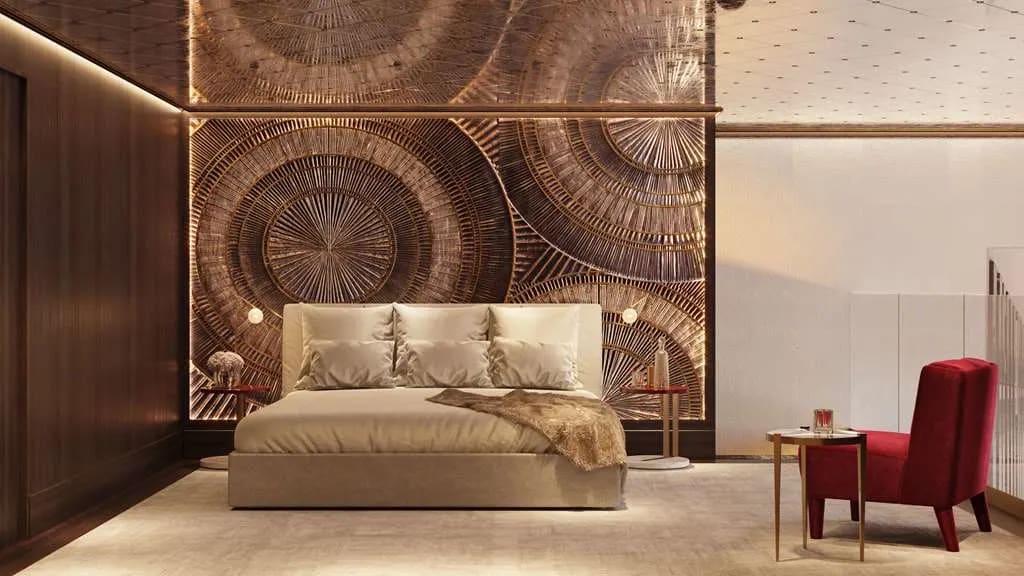
Image courtesy of Almanac Vienna
Vienna blends imperial grandeur with everyday elegance. This is a city where classical music fills the air, coffee culture is a ritual and landmarks like Schönbrunn Palace and the Vienna State Opera are just part of daily life. Choosing the right place to stay lets you experience Vienna at your own rhythm, whether it’s a historic hotel or a modern retreat.
Where to stay
Rosewood Vienna: Set in a restored historic building just steps from St. Stephen’s Cathedral, this retreat feels both grand and intimate. Timeless Viennese charm, plush rooms and a rooftop restaurant provide the perfect sanctuary after a day exploring all Vienna has to offer.
Fora’s Rosewood Elite partner perks include a welcome amenity, daily breakfast, upgrade and extended check-in/out whenever possible.
Almanac Vienna: A sleek, bold city escape in the heart of Vienna’s historic first district. This modern boutique hotel features custom-made large beds and polished interiors for a stylish but unfussy stay that’s walking distance to Vienna’s top museums, shopping and restaurants.
Fora Reserve perks include spa access, daily breakfast, an upgrade and extended check-in/out whenever possible.
River Cruises
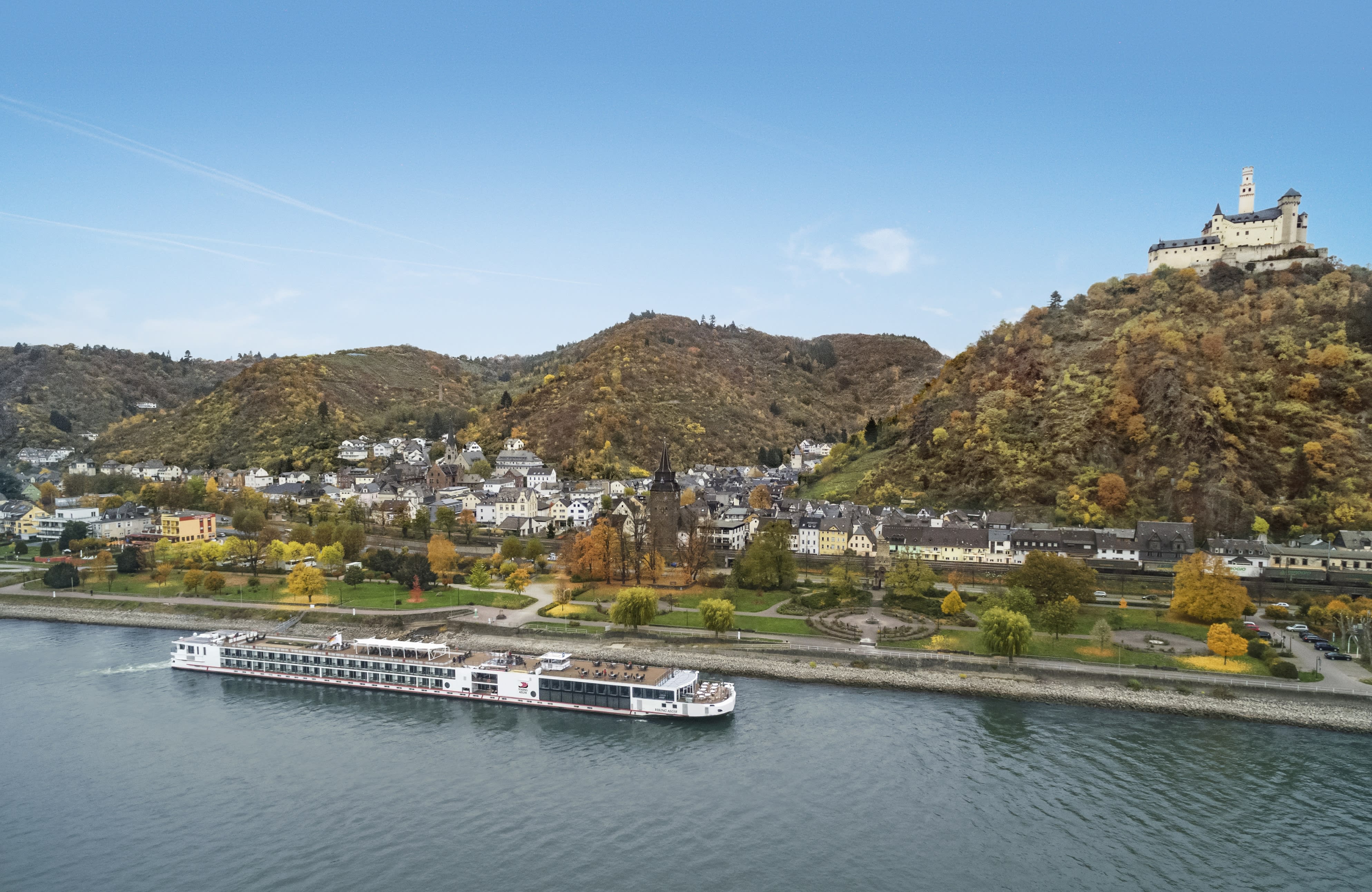
Image courtesy of Viking River Cruises
Germany and Austria are top picks for river cruising, with routes that follow the Rhine, Moselle, Main and Danube through vineyards and past castles. Stop at charming towns and culture-rich cities like Cologne, Passau and Vienna. Some stay within Germany while others will take you to neighboring countries like the Netherlands, France, Switzerland, Czechia and others.
Viking River Cruises (Rhine, Danube, Main, Moselle, and Elbe): A favorite for first-time river cruisers, Viking is known for its sleek Scandinavian ships, included excursions and enriching onboard talks that dive into the history and culture of each stop.
AmaWaterways (Rhine, Moselle, Main, Danube and occasionally the Elbe): Perfect for food lovers, active travelers and couples looking for something special. Award-winning cuisine, wellness classes and even bikes are offered to guests who want to explore on two wheels.
Avalon Waterways (Rhine, Main, Moselle and Danube): Focused on the view, Avalon’s Panorama Suites bring the riverfront right to your bed. Their Active & Discovery cruises offer flexibility, with everything from hiking and kayaking to cooking classes and museum tours.
Uniworld (Rhine, Danube, Main and Moselle): The boutique hotel of river cruising. Think elegant, themed ships, fine dining. Couple that with standout service and all-inclusive experience for a luxurious experience that feels personalized from start to finish.
History and culture
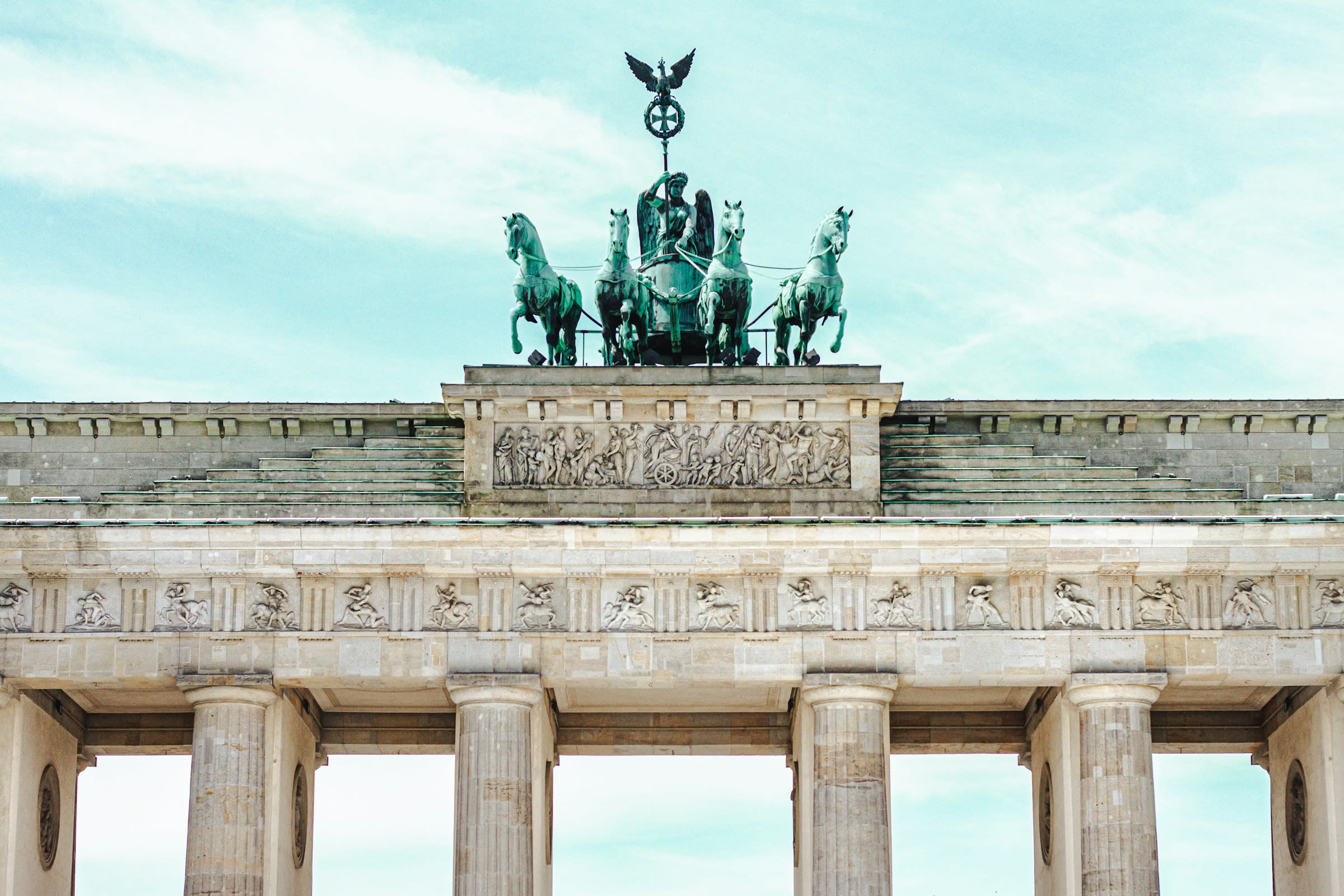
Austria and Germany are steeped in centuries of history that still shape everyday life, from grand architecture to local traditions. Germany’s story spans back to the Holy Roman Empire through to Prussia. The scars of WWII and a remarkable reunification in 1990 are also tangibly felt at Berlin’s Brandenburg Gate and the remnants of the Berlin Wall.
In Austria, echoes of the once-mighty Habsburg Empire are everywhere: in Vienna’s Schönbrunn and Hofburg Palaces, where imperial splendor meets everyday city life. The continued love for classical music is everywhere, with composers like Mozart and Strauss still celebrated in elegant concert halls.
Both countries share a deep respect for ritual and heritage — whether it’s the precision of a Munich beer hall, a Vienna opera performance, or a procession of Krampus runs and Christmas markets in alpine towns. In Salzburg, locals still follow Catholic feast days with parades and traditional dress, while spa culture in Baden-Baden remains as much about wellness as it is about social connection — a tradition dating back to Roman times. Together, Austria and Germany offer travelers a chance to step into living history, where cultural pride, artistic legacy and everyday rituals continue to define the rhythm of modern life.
Cultural celebrations and events
Berlinale (Berlin, February): One of the most important film festivals in the world, the Berlinale draws filmmakers, industry insiders and movie lovers for a week of premieres, red carpets and the coveted Golden Bear award.
Vienna Opera Ball (Vienna, February): Glamorous and traditional, this black-tie event kicks off the Viennese ball season with a night of waltzing, music and high society at the iconic Vienna State Opera.
Wiener Festwochen (Vienna, May–June): A creative, city-wide celebration of theater, music and dance that brings global talent to Vienna’s stages, from experimental productions to classical performances.
Salzburg Festival (Salzburg, late July–August): One of Europe’s most celebrated arts festivals, this event fills Salzburg with world-class opera, concerts and theater in a dramatic Alpine setting.
Oktoberfest (Munich, late September–early October): It’s the world’s biggest beer festival for a reason—Oktoberfest delivers steins of Bavarian beer, traditional dress, festive parades and serious good times.
Nuremberg Christmas Market (Nuremberg, late November–December): Step into a real-life snow globe with this historic holiday market featuring handmade crafts, mulled wine, gingerbread and cozy winter charm.
Activities
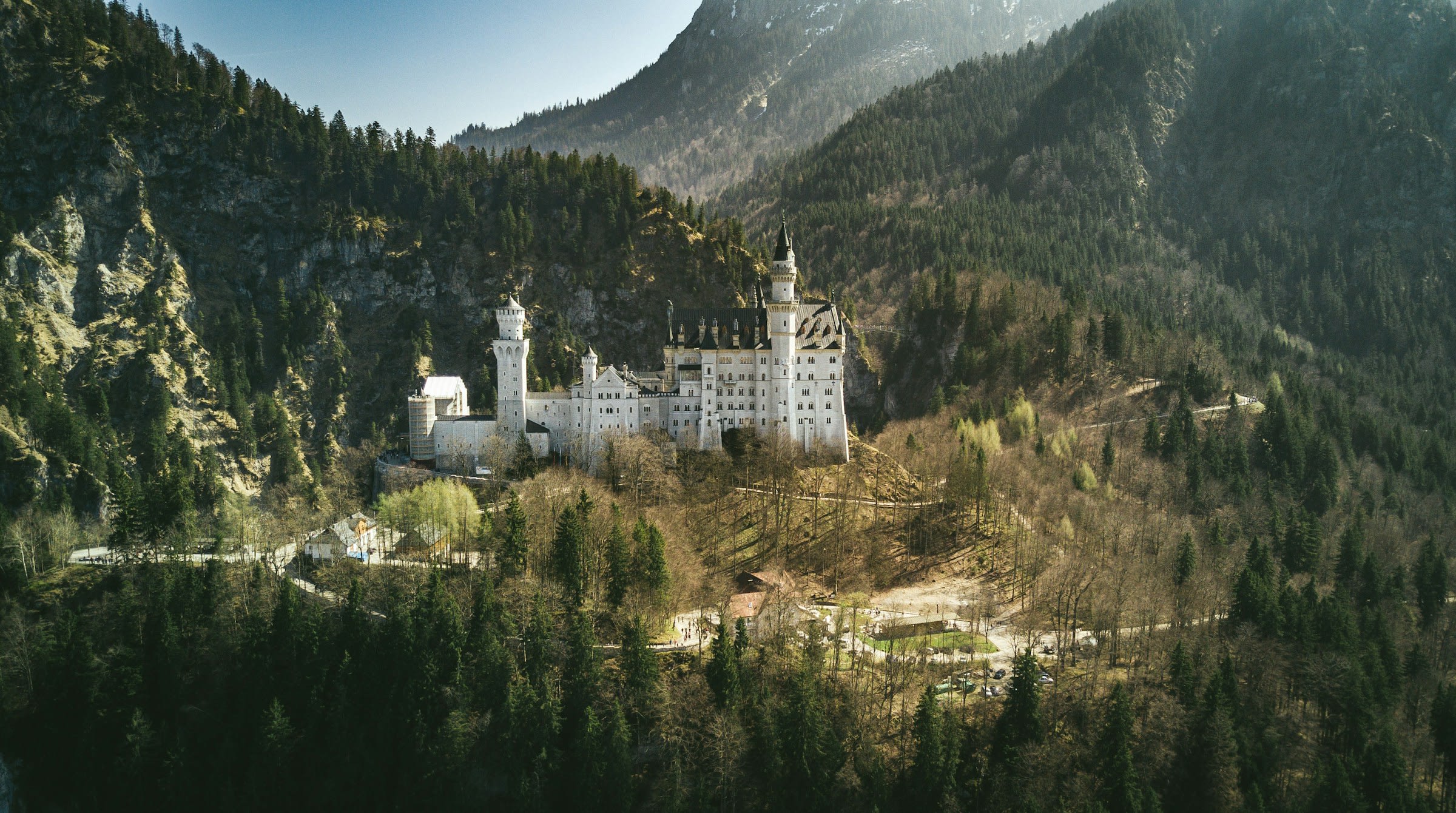
World-class culture, outdoor adventures, spa days and historic strolls. Germany and Austria offer plenty of ways to fill your days, no matter your travel style.
Berlin
Landmarks: Start with the classics. Walk down Unter den Linden and check off big-name sights like the Brandenburg Gate and Reichstag. Head to the top of the Reichstag’s glass dome for one of the best views in the city.
Art: Get a feel for Berlin’s creative side at Museum Island. See pieces of the Berlin Wall at the East Side Gallery, an open-air art exhibit.
Nature: For a quieter break, wander the Berlin Botanical Garden. Rent a bike and cruise through the Tiergarten, Berlin’s version of Central Park.
Shopping: Browse designer shops in Mitte or stroll the iconic Kurfürstendamm. On weekends, go local with a trip to Mauerpark for vintage finds. Check out Markthalle Neun for street food and handmade goods.
Cultural activities: Berlin’s event calendar is always packed. Spend the evening at the Berlin State Opera or catch something avant-garde at the Berliner Ensemble. Wrap it up with a rooftop drink overlooking the city skyline.
Baden-Baden
Thermal baths: Start in the heart of town with a soak at one of Baden-Baden’s famous thermal baths. Friedrichsbad and Caracalla Therme both offer a mix of old-world charm and spa-day bliss. Their waters have been flowing since Roman times.
Lichtentaler Allee: Take a slow stroll down Lichtentaler Allee, a tree-lined promenade with gardens, museums and grand villas that channel 19th-century elegance.
Nature: Head into the Black Forest. The hike from St. Märgen to St. Peter is a favorite. Pack a picnic with fresh bread, cheese and local beer from Freiburg’s market to enjoy alongside panoramic views, forest trails and quiet villages. You can catch the bus back.
Museum Frieder Burda: Don’t miss the Museum Frieder Burda, a striking glass building in the park that houses an impressive collection of modern art.
Cooking class: For something hands-on, join a local cooking class and master the art of making Black Forest cake with real cherry schnapps.
Munich
Landmarks: Start in Marienplatz, the city’s central square, where the Glockenspiel draws a crowd and gothic spires tower above. Just around the corner, Viktualienmarkt is your go-to for local bites, fresh produce and beer gardens.
Nature: Spend an afternoon in the English Garden, a massive green space where river surfers ride the Eisbach wave and shady trails lead to relaxed beer gardens like the one under the Chinesischer Turm.
Shopping: Head to Herzogstraße in Schwabing. It’s a stylish stretch of indie boutiques, local labels and cozy cafés perfect for people-watching.
Neuschwanstein Castle: Take a day trip to Neuschwanstein Castle, the iconic hilltop stunner that inspired Disney. It’s just a couple hours from Munich and well worth the detour.
Salzburg
Old Town: Get your bearings in Salzburg’s UNESCO-listed Old Town, a maze of narrow streets, historic squares and storybook charm.
Arts & culture: Step into Mozart’s Birthplace to see where it all began. Head to the DomQuartier for a mix of museums, cathedral art and rooftop views across the city.
Nature: Take a stroll through Mirabell Gardens where fans of “The Sound of Music” will recognize the setting. Cross the river for a relaxed lunch with scenic views.
Fortress Hohensalzburg: Head up to Fortress Hohensalzburg, the city’s hilltop icon. Hike the path to the top or hop on the funicular.
Music: If you’re visiting in summer, catch a performance during the Salzburg Festival. Year-round you can also listen for live classical music drifting from the city’s churches.
Countryside: For a quick escape, the countryside just outside Salzburg delivers rolling hills, alpine lakes and quiet paths perfect for a bike ride or breezy day trip.
Vienna
Landmarks: Walk through St. Stephen’s Cathedral, where you can admire the colorful tiled roof. Climb the South Tower for stunning views. Visit Belvedere Palace to see Klimt’s The Kiss, along with impressive gardens and art collections.
Ringstrasse: Take a tram ride along the Ringstrasse, passing sites like the State Opera and Hofburg Palace, then visit the quirky Hundertwasserhaus.
Schönbrunn Palace: Explore Schönbrunn Palace, the summer home of the Habsburgs, with its baroque design and lush gardens.
Secessionist Vienna: Discover the Vienna Secession art movement that’s closely related to Art Nouveau. See the Naschmarkt, Secession Building or even explore a private Art Nouveau apartment.
History: History buffs can dive into Jewish Vienna with visits to Leopoldstadt, the Shoah Wall of Names and Sigmund Freud’s former apartment.
Day trips from Germany and Austria
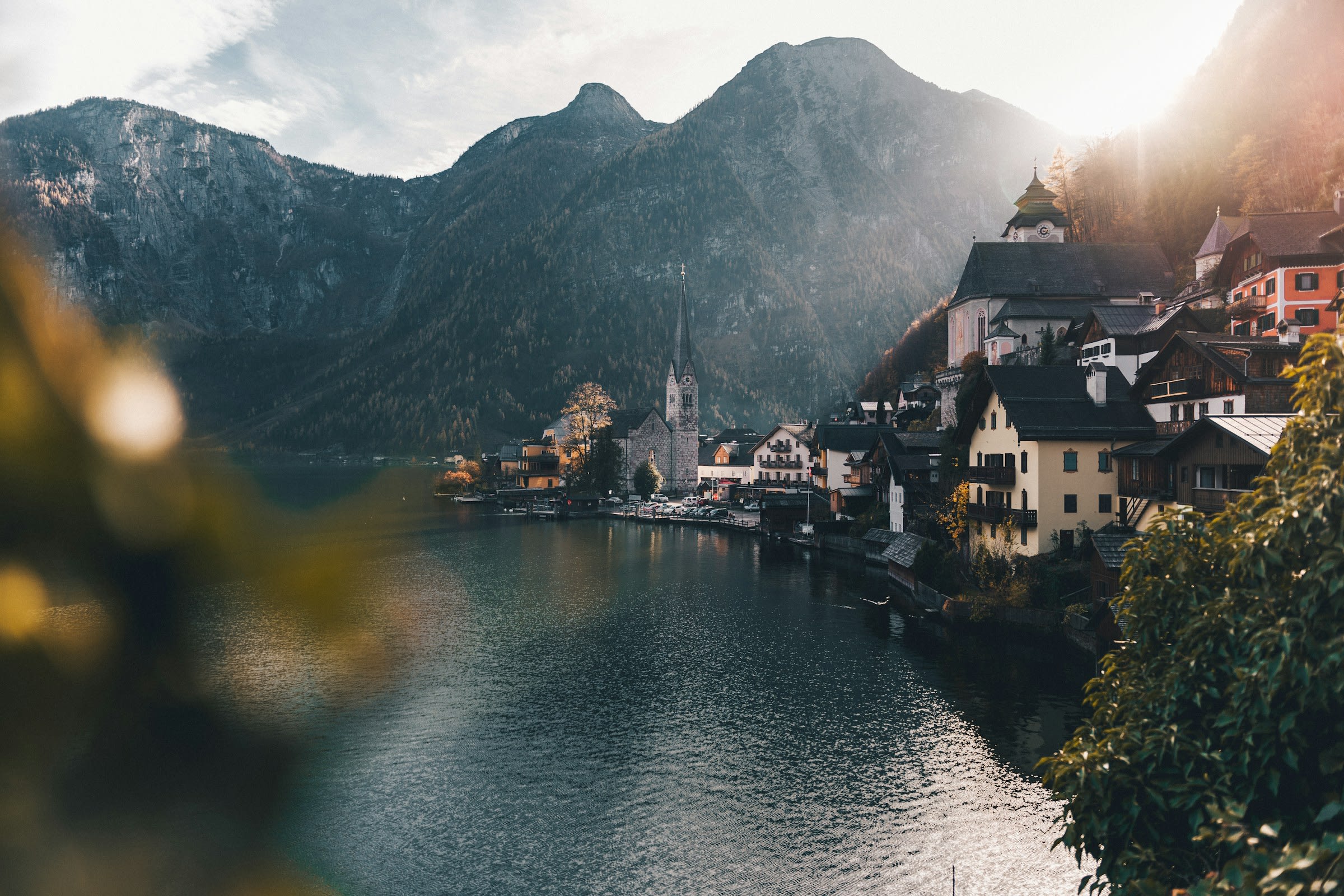
Wherever you’re based, there’s no shortage of postcard-worthy escapes just a train ride away. These day trips offer a mix of alpine adventure, fairytale villages and old-world charm. It’s perfect for slowing down and soaking in something new.
Lake Königssee (1.5 hrs from Salzburg): Ride an electric boat across this glassy alpine lake, hemmed in by dramatic cliffs. Pause mid-journey for an echo demonstration and visit the red-domed church of St. Bartholomew on the water’s edge.
Mittenwald (1.5 hrs from Munich): This colorful alpine village is known for its violin-making heritage and painted facades. Spend the day browsing artisan shops or head into the mountains for a scenic hike.
Hallstatt (1.5 hrs from Salzburg): Austria’s most photographed village lives up to the hype with its lakeside setting, pastel houses and salt-mining history. A quick visit feels like stepping into a postcard.
Schiltach (1–1.5 hrs from Baden-Baden): Nestled in the Black Forest, Schiltach charms with timbered houses, quiet river paths and family-run workshops where traditional crafts still thrive.
Rothenburg ob der Tauber (2–2.5 hrs from Munich): Step back in time in this walled medieval town. Walk the ramparts, explore quaint lanes, and stop by the year-round Christmas Museum for a festive fix.
Bamberg (2.5 hrs from Munich): With its UNESCO-listed Old Town, riverside beer gardens and signature smoked beer, Bamberg offers a vibrant yet relaxed alternative to bigger cities.
Görlitz (3 hrs from Berlin): Known as one of Germany’s most beautiful towns, Görlitz is a favorite film location thanks to its mix of Gothic, Renaissance and Art Nouveau architecture—ideal for slow travelers and design lovers.
Add-on destinations
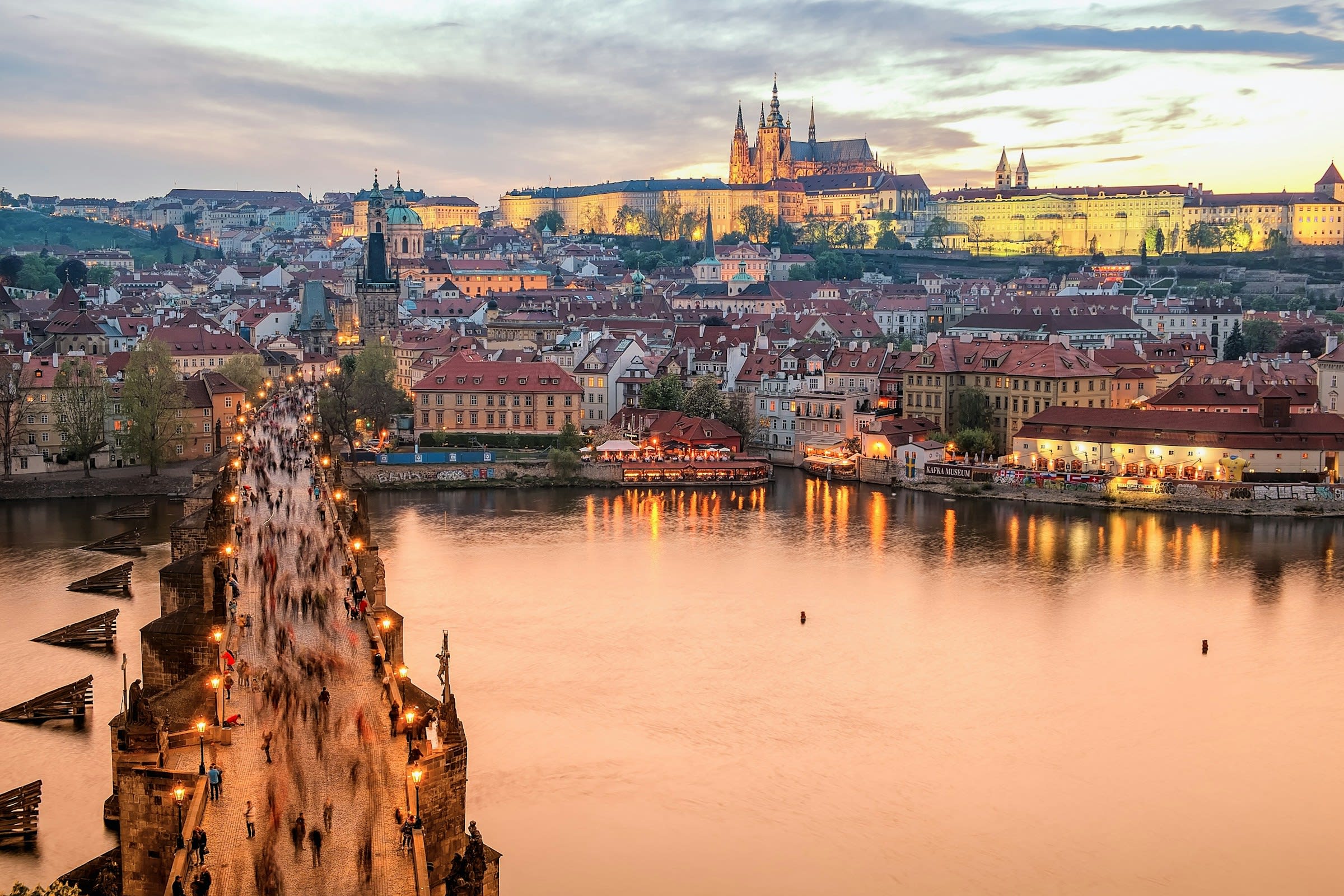
If you're looking to expand your trip, these nearby destinations make excellent add-ons—easy to reach by train or short flight, and packed with their own unique culture, cuisine and character.
Frankfurt (1–2 hours by train from Munich or Stuttgart): Often seen as just a business hub, Frankfurt has a blend of glassy skyscrapers and charming old town corners. Tour Goethe’s birthplace, stroll the museum-filled riverbank and sip apple wine in taverns of Sachsenhausen.
Cologne (1 hr from Frankfurt, 4.5 hrs from Munich): Home to Germany’s most iconic cathedral, Cologne pairs Gothic grandeur with a relaxed, local vibe. Browse contemporary art museums, cruise the Rhine River and toast with a crisp Kölsch in a riverside beer hall.
Hamburg (1 hr flight or 5 hrs by train from Munich): This port city blends industrial grit with polished modernity. Explore the cutting-edge Elbphilharmonie, wander through historic warehouse districts or relax by the city’s many canals and lakes.
Dresden (2 hrs by train from Berlin): Once dubbed the “Florence on the Elbe,” Dresden is a city of resilience and refinement. See baroque architecture at Zwinger Palace, stroll along the Elbe River promenade, or catch a classical concert in the rebuilt Frauenkirche.
Prague (4 hrs by train from Munich or Vienna): Just across the border, Prague draws you in with its cobbled lanes, hilltop castle and storybook spires. It’s compact, walkable and full of old-world beauty — with standout beer and café culture to match.
Budapest (2.5 hrs by train from Vienna): Straddling the Danube, Budapest is a city of striking contrasts. Grand thermal spas and gritty ruin bars, ornate architecture and buzzing nightlife perfectly mix history and modern-day cool.
Kraków (3.5 hrs from Dresden, 7 from Vienna): Poland’s cultural gem offers a poignant mix of medieval charm and deep history. Walk the old town, visit the Wawel Royal Castle and reflect at nearby memorials. After, unwind with hearty meals and a lively café scene.
If not Austria or Germany…
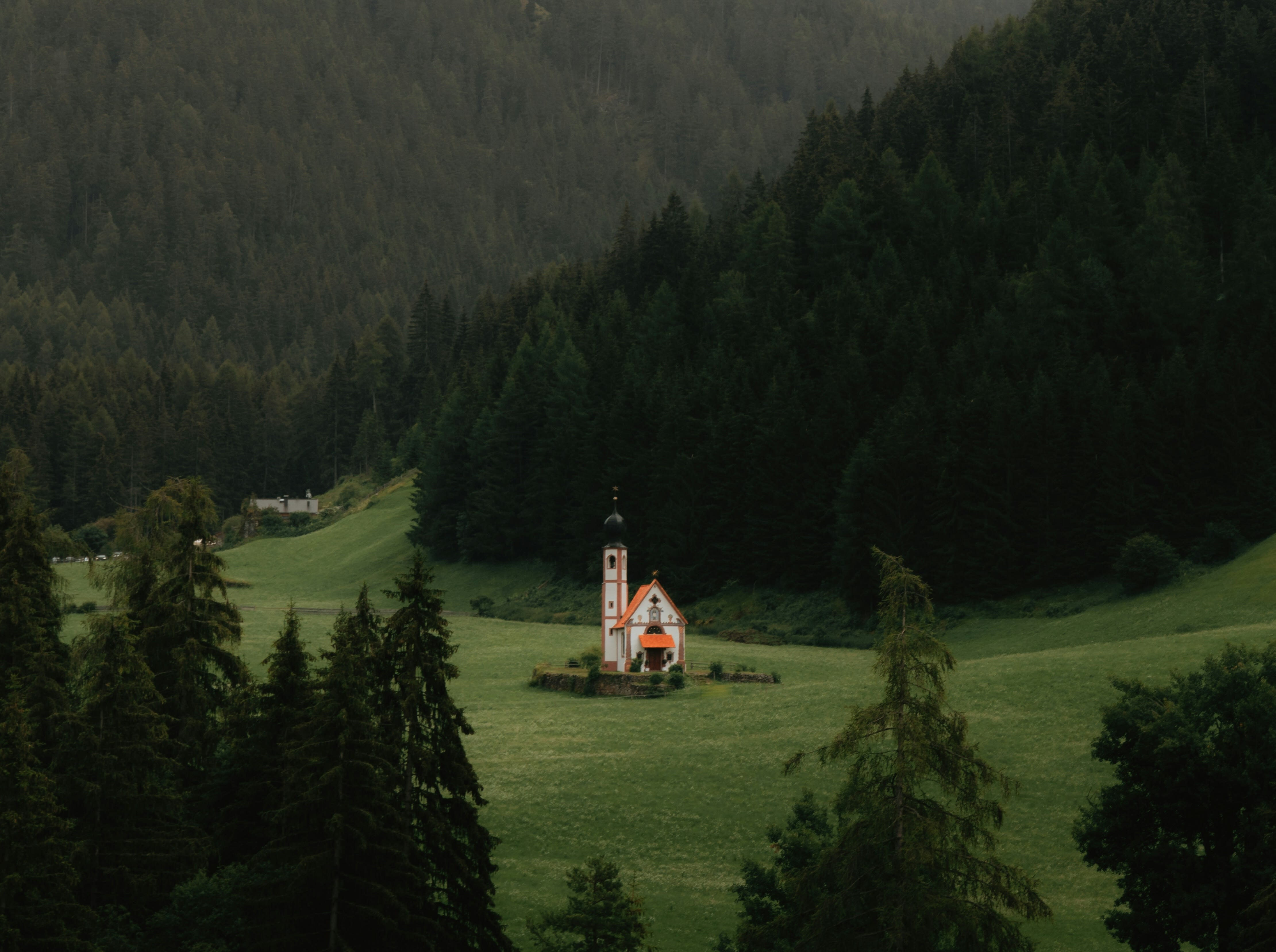
If you love the charm of alpine villages, rich history and walkable old towns, these destinations serve up similar vibes with their own unique flavor:
Switzerland: Snow-capped peaks, shimmering lakes and cities like Zurich and Lucerne make Switzerland feel like a real-life postcard. Add in sleek trains and polished hotels, and you’ve got a dream for nature lovers and luxe travelers alike.
Slovenia: Small but stunning, Slovenia pairs alpine beauty with a relaxed pace. From the emerald waters of Lake Bled to the storybook streets of Ljubljana, it’s Austria’s cool little cousin with a wild side.
Czechia: Step outside the capital and you’ll find spa towns like Karlovy Vary and the fairytale charm of Český Krumlov. Perfect for travelers into castles, cobblestones and a more local, laid-back rhythm.
South Tyrol, Italy: This mountain region where Austria meets Italy blends alpine living with Italian flair. Hike the Dolomites by day (recently featured on Fora’s 2025 Hot List), then dine on pasta with a side of strudel in elegant towns like Bolzano and Merano.
Alsace, France: Half-timbered houses, flowing wine and a heavy dose of German influence make Alsace a favorite for festive travelers. Cozy villages, vineyard drives and some of Europe’s most magical Christmas markets.
